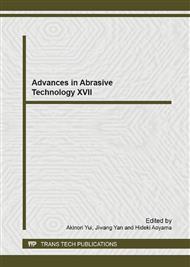p.473
p.479
p.485
p.489
p.495
p.500
p.509
p.515
p.520
Influence of Processing Parameters on Surface Roughness in Micro Mill-Grinding Aluminium Alloy 6061
Abstract:
Orthogonal experiments of micro mill-grinding were conducted on aluminium alloy 6061. Electroplated CBN compound tools were used in machining. Surface topography and roughness of the machined workpieces were measured and analyzed. Influence rules of radial cutting depth,feed rate and spindle speed on surface roughness in micro mill-grinding were studied. The results were compared with those in micro milling. It shows that the influence rules of processing parameters on surface roughness in micro mill-grinding are approximately same with those in micro milling. And in the same processing conditions, the surface roughness of micro mill-grinding is better than that of micro milling. The minimum value of surface roughness Ra of micro mill-grinding is 0.609μm in the experiments.
Info:
Periodical:
Pages:
495-499
Citation:
Online since:
September 2014
Authors:
Price:
Сopyright:
© 2014 Trans Tech Publications Ltd. All Rights Reserved
Share:
Citation:


